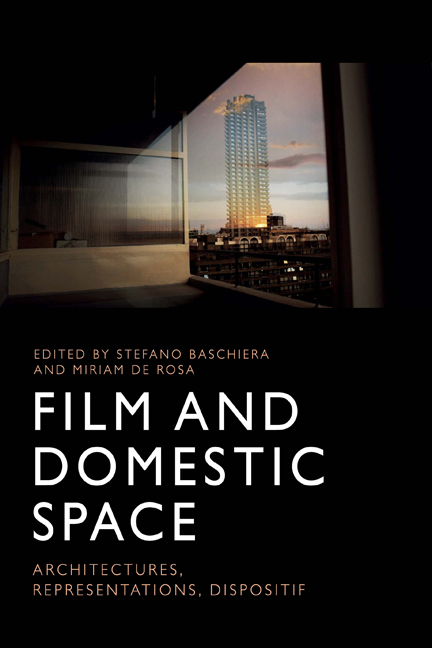Book contents
- Frontmatter
- Contents
- List of Figures
- Notes on the Contributors
- Acknowledgements
- Introduction
- 1 Architectures of Ubiquity: The Colonial Revival in Film and Television
- 2 No Down Payment: Whiteness, Japanese American Masculinity and Architectural Space in the Cinematic Suburbs
- 3 Resist, Redefine, Appropriate: Negotiating the Domestic Space in Contemporary Female Biopics
- 4 Liminal Spaces, Lesbian Desire and Veering off Course in Todd Haynes’s Carol
- 5 A Home on the Road in Claire Denis’s Vendredi soir
- 6 Acoustic Ectoplasm and the Loss of Home
- 7 Our House Now: Flat and Reversible Home Spaces in Post-war Film and Television
- 8 From Myth to Reality: Images of Domestic Space in Post-Soviet Baltic Films
- 9 No | Home | Movie: Essay Film, Architecture as Framing and the Non-house
- 10 At Home with the Nouvelle Vague: Apartment Plots and Domestic Urbanism in Godard’s Une femme est une femme and Varda’s Cléo de 5 à 7
- 11 Dwelling the Open: Amos Gitai and the Home of Cinema
- 12 What Is Cult When It’s At Home? Reframing Cult Cinema in Relation to Domestic Space
- 13 High-fructose Cinema and the Movie Industrial Complex: Radicalising the Technology of Representation in a Domestic Kind of Way
- Index
13 - High-fructose Cinema and the Movie Industrial Complex: Radicalising the Technology of Representation in a Domestic Kind of Way
Published online by Cambridge University Press: 22 September 2020
- Frontmatter
- Contents
- List of Figures
- Notes on the Contributors
- Acknowledgements
- Introduction
- 1 Architectures of Ubiquity: The Colonial Revival in Film and Television
- 2 No Down Payment: Whiteness, Japanese American Masculinity and Architectural Space in the Cinematic Suburbs
- 3 Resist, Redefine, Appropriate: Negotiating the Domestic Space in Contemporary Female Biopics
- 4 Liminal Spaces, Lesbian Desire and Veering off Course in Todd Haynes’s Carol
- 5 A Home on the Road in Claire Denis’s Vendredi soir
- 6 Acoustic Ectoplasm and the Loss of Home
- 7 Our House Now: Flat and Reversible Home Spaces in Post-war Film and Television
- 8 From Myth to Reality: Images of Domestic Space in Post-Soviet Baltic Films
- 9 No | Home | Movie: Essay Film, Architecture as Framing and the Non-house
- 10 At Home with the Nouvelle Vague: Apartment Plots and Domestic Urbanism in Godard’s Une femme est une femme and Varda’s Cléo de 5 à 7
- 11 Dwelling the Open: Amos Gitai and the Home of Cinema
- 12 What Is Cult When It’s At Home? Reframing Cult Cinema in Relation to Domestic Space
- 13 High-fructose Cinema and the Movie Industrial Complex: Radicalising the Technology of Representation in a Domestic Kind of Way
- Index
Summary
There is a crack in everything … that's how the light gets in. (Leonard Cohen, Anthem, 1992)
I have a memory of my mother tucking me into bed on New Year's Eve in 1962. It is a visceral recollection involving all my senses; the soft, tactile feel of the cotton sheets, the fresh scent of the quilt pushed close to my chin and, on hot summer nights, there was the cool, plaster wall that I would press my face into and make contact. My pillow was old and misshapen; however, each night my head would find its way to it's soft, welcoming exhale.
In 1962 I was four years old. That particular night I was allowed to stay up late as a special treat. I imagined that as I grew older I might come to understand what all the fuss was about. However, to this day the meaning and value of the New Year's Eve holiday escapes me. Holidays and vacations are both strange and uncomfortable concepts. In my mind, the idea of a vacation is pointless if one understands the term, as I do, as an expression of withdrawing. Unless we are talking about the hallucinatory promise of sensory deprivation tanks, the idea of leaving oneself behind, even if only for a few hours, is an unimaginable proposition (Lilly and Leary 1988: 102). On that particular evening in 1962, after my mother kissed me and said good night, we re-enacted our daily pantomime of leaving my bedroom door open ‘just a crack’. The idea was that this sliver of light might allow the warmth of all things domestic and safe to penetrate my room and stave off fearful imaginings as I lay in my bed, alone in the dark.
The interior geography of our small, two-bedroom house consisted of a long hallway that linked my bedroom to the kitchen, living room, my parents’ bedroom and the one bathroom that the three of us shared. This artery not only connected the different rooms, but it also functioned as a mixing board and echo chamber for all the goings-on in the house.
- Type
- Chapter
- Information
- Film and Domestic SpaceArchitectures, Representations, Dispositif, pp. 226 - 236Publisher: Edinburgh University PressPrint publication year: 2020



